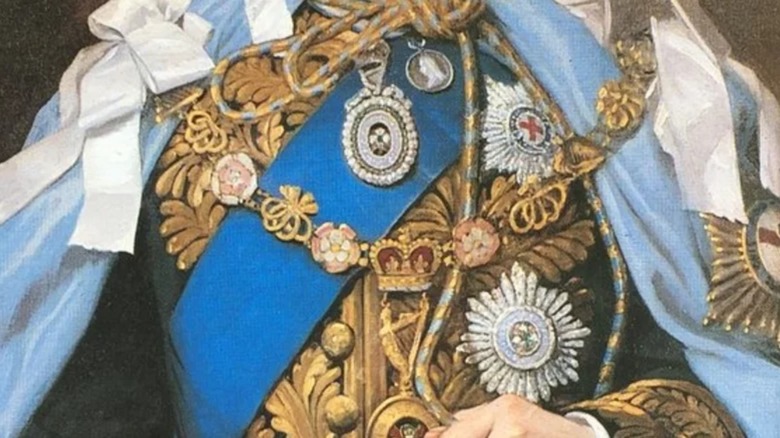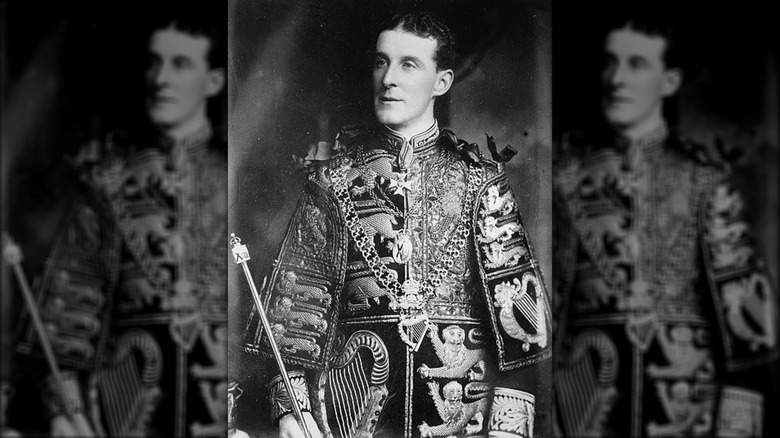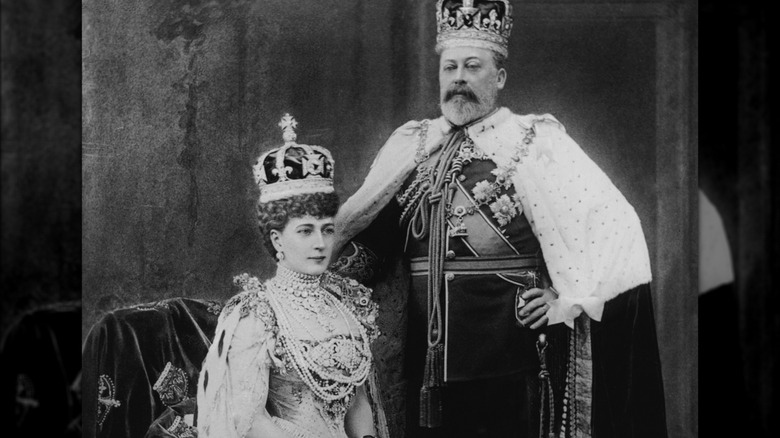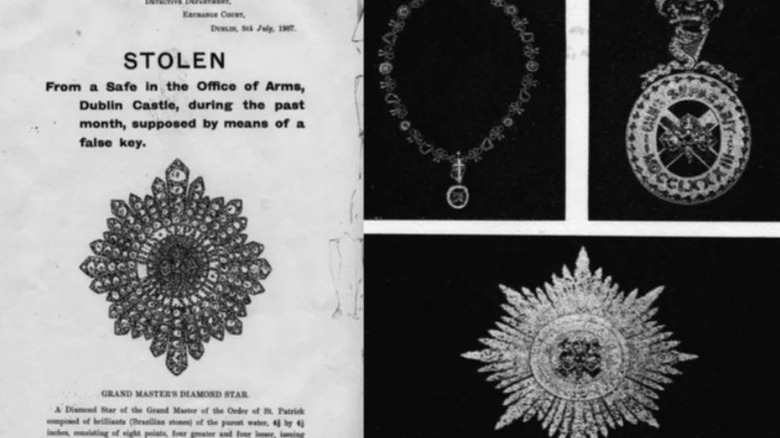The Mystery Of The Crown Jewels Of Ireland
In 1831 the Irish Crown Jewels were commissioned as symbols of the British Crown's power over Ireland. Whenever the King or Queen visited the island, the jewels, consisting of "a jeweled star of the Order of St. Patrick and a diamond brooch and five gold collars," says History Ireland Magazine, were kept there for the monarch to wear on formal occasions. Ireland was under British rule until 1922, and, prior to that the British monarch — who at the time was referred to as the King or Queen of the United Kingdom of Great Britain and Ireland — would also automatically receive the title of the Sovereign of the Grand Master of the Order of St. Patrick. It was in relation to duties of the Order — such as knighting people — that the monarch would wear the Irish Crown Jewels. At other times, they were stored securely at Dublin Castle per the protocol of the Order.
However, the defense of the jewels was far from airtight. In 1903, security began to lapse, ironically, with the building of a new strongroom at Dublin Castle. While the room itself was completed professionally, in a moment of pure farce officials discovered that the safe in which the Crown Jewels of Ireland were traditionally kept was too big to fit into the room. The man in charge of the protection of the jewels was a man named Arthur Vicars, the Ulster King of Arms, who suggested that the safe be moved to his library.
A grand theft
Despite having a long and distinguished career, Arthur Vicars was far from ideal for the job of Ulster King of Arms. He had a habit of showing the precious Crown Jewels of Ireland in his possession to his many guests, and often misplaced his keys, including those to the safe. In one instance, the Crown Jewels were stolen as a joke while Vicars was drunk, according to Dublin Castle.
In early 1907 the Irish Crown Jewels were under lock and key in preparation for the summer arrival of King Edward VII, who was due to wear them at the 1907 Irish International Exhibition. However, things were off from June 28 to July 6. According to Owlcation, in that time Vicars lost his key to Bedford Tower, did nothing when the cleaning woman later found the tower door unlocked and also did nothing on July 6 when she found a strongroom key both in its lock and on a ring with a library key. Hours later, when the library's sentry was sent to put a repaired collar in the safe, he found it unlocked and almost completely empty (via Atlas Obscura). The Irish Crown Jewels were gone.
Vicars Vilified
As the dust settled and the Order of St. Patrick realized they had been the victims of one of the biggest heists in Irish history, the bizarre circumstances that led to the loss of the priceless jewels started coming to light. Such as the fact that Arthur Vicars was something of a party animal who was so drunk that it affected the execution of his duties, such as the protection of the Irish Crown Jewels.
Vicars, himself a prime suspect and desperate to prove his innocence, even went so far as to attend a seance that was recommended to him (via The Vintage News). He then spent time furiously searching a cemetery once it was claimed at this gathering that the jewels were buried there — they were not. Growing desperate, Vicars even considered bringing in his cousin, the Sherlock Holmes author Arthur Conan Doyle, to use his crime writer's mind to potentially help crack the case. Of course, he was unsuccessful, and Vicars was eventually cast into exile, his career destroyed by the scandal which meant that the Irish Crown Jewels were unable to present at that year's Irish International Exhibition, to the great embarrassment of King Edward VII (pictured), per the BBC.
Nevertheless, some have argued that Vicars was unfairly scapegoated for the loss of the jewels and that even with his seemingly decadent lifestyle and erratic manner he was not ultimately responsible for the jewels' disappearance.
So who took the jewels?
The ultimate fate of the Irish Crown Jewels remains a mystery to this day: they have never been recovered, and the original reward of 1,000 pounds that was posted for its recovery is still unclaimed over a century after the jewels went missing.
The identity of the thief or thieves was never ascertained in the aftermath of the heist, though many became deeply invested in solving the mystery, including Scotland Yard detective John Kane, whose official report was abruptly concealed. Some claimed that the investigation was suppressed after police uncovered a culture of debauchery and sexually promiscuous behavior at Dublin Castle, which would have caused an even bigger scandal, though this theory has never been identified.
In the years since, countless sleuths both professional and amateur have drawn their conclusions as to what happened to the priceless symbols of the Order of St. Patrick. Per the BBC, some politicians claimed that Irish Unionists had stolen the jewels, and a rumor claimed that they had then been smuggled to the U.S. While Arthur Vicars himself remained the prime suspect in many people's eyes, others claimed that the jewels were stolen by Vicars' mistress and that she fled with them to France. However, after his frantic efforts to recover the jewels, Vicars himself eventually accused Francis Shackleton, the brother of the explorer Ernest Shackleton, who Vicars claimed had a key to the safe and used the jewels to pay his debts. Some modern researchers have agreed Vicars' story is possible — and that the thief likely got Vicars drunk to accomplish it.



